Famous Residents of Erie Cemetery
Get insight into the lives of people who helped shape the Erie community.
Alexander W. Brewster
1796 - 1851

Brewster was one of the original incorporators and was the first person buried in Erie Cemetery.
In his early years he taught at the log house at 7th and Holland, and later at the Erie Academy. A prominent merchant and manufacturer, he was elected sheriff in 1828 and burgess of Erie in 1849. The old Brewster Home built in 1823 and refurbished by Erie Insurance in 1984, stands beautifully today on East 5th between Holland and French.
William Himrod Sr.
1791 - 1870

Himrod came to Erie in 1810 and worked as a carpenter and joiner until 1840. At that time, he became involved in the establishment of a stove, agricultural implement and engine manufacturing works of Johnson, Himrod & Co., a business which ultimately developed into the Chicago and Erie Stove Works and the Erie City Iron Works.
He was one of the city fire wardens in 1853; a member of the common council in 1856-7; a director in the branch U.S. bank; and one of the incorporators of the Erie Cemetery. He provided a shelter for fugitive slaves and founded, at his own expense, The Himrod Mission Sunday-School, to provide Bible education to African Americans. He served as its supervisor until he died when his son, William Jr., succeeded him.
The first monument in Erie Cemetery was erected at Himrod's grave.
Thomas Forster
1762 - 1836

Born near Harrisburg, he served in the Revolution and was a colonel of volunteers during Whiskey Rebellion and also served as captain in the War of 1812.
Forster was a collector for the Port of Erie (1799-1836), and was the originator of the Erie and Waterford Turnpike.
Sarah A. Reed
1838 - 1934
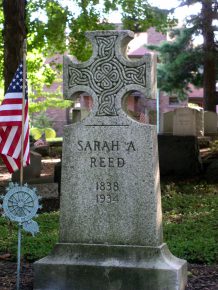
Reed is the great-granddaughter of Erie's first settlers, Colonel Seth Reed and Hannah Reed.
She was a major force in the cultural and charitable activities of the community for almost 70 years and served as president of the Home for the Friendless for 44 years. Following her death, the name of the institution was changed to Sarah A. Reed Home.
Pierre Simon Vincent (P.S.V.) Hamot
1783 - 1846

Born in Paris, this French immigrant and skilled businessman began in the salt trade and soon became one of Erie's most successful merchants.
One of Erie's first philanthropists, he donated the land overlooking the bay at State and 2nd streets for Hamot Hospital, with the provision that no one ever be denied medical treatment there.
The Reed Family
0 - 0

No family played as great a part in the early history of Erie as that of the descendants of Erie's first settler, Colonel Seth Reed and his wife Hannah.
That distinction is reflected in the fact that the Reed Family plot is the only one to occupy its own mound surrounded by a walkway. The centerpiece of the plot is a granite pillar topped with a life-sized statue of a woman, perhaps looking to the family farm on Walnut Creek.
Colonel Seth Reed
1744 - 1797

A veteran of the Battle of Bunker Hill in the Revolutionary War, Reed was the first settler to arrive in Erie in July 1795 with his wife, Hannah, and two of his sons. They erected a one-story log cabin covered with bark at the mouth of Mill Creek and labeled it the "Presque Isle Hotel." This was the first building in Erie.
Rufus S. Reed
1775 - 1846

Son of Colonel Seth Reed, he was one of Erie's first and most successful capitalists.
He opened a store in 1796 doing business with settlers, soldiers, and native tribespeople. He later secured large government contracts to supply western military posts with beef, pork, flour and whiskey. He served as burgess of Erie in 1841. Seven years later he owned an extensive fleet of lake vessels.
His second wife was the daughter of General William Irivine, who, with Andrew Ellicot laid out the town of Erie in 1795. Rufus and Agnes had one son, Charles M. Reed.
Charles M. Reed
1803 - 1871

Charles was educated in Washington, PA, then went to Philadelphia where he read law and was admitted to the bar in 1821. He returned to Erie and became the largest owner of steamboats on the Great Lakes. He was instrumental in developing the Erie Extension Canal and was one of the first to build railroads in the Erie area.
He served for one year in the State Legislature and a term in Congress. Reed died in his mansion at the corner of West 6th and Peach, known today as the Erie Club. His fortune at the time of his death was estimated to be between $5 and $15 million.
Giles Sanford
1782 - 1866

Born in Connecticut, he came to Erie in 1810 and for many years was a partner of Rufus S. Reed, with whom he helped provide suppliers for the building of Perry's fleet.
He was a descendant of John Sanford who served as president of Rhode Island in 1655. Sanford assisted substantially in the promotion of local agricultural and horticultural interests and may truly be termed the father of our natural history society.
Judah Colt Spencer
1813 - 1885

Born in Connecticut, he came to Erie in 1829 to take a position in the land office of his uncle, Judah Colt, succeeding to the business on Colt's death in 1832.
Spencer played an important role in the early history of the Erie and North East Railroad and was president of the Common Council of Erie. One of the Founders of the First National Bank, he served as its president for 22 years and was president of Erie Cemetery for more than 20 years.
Judah Colt
1761 - 1832

Colt came to Erie County in 1795 to purchase land, and was appointed the general agent for the Pennsylvania Population Company, which held the warrants for all the land in the triangle. He opened a land office which has since been known as "Colt Station" and opened a road from Lake Erie at the mouth of 16 Mile Creek where he furnished suppliers to settlers on generous terms of credit. One of the most widely known and respected of the earliest settlers in this area, he served as burgess of Erie, 1813, 1820-21.
William L. Scott
1828 - 1891

Born in Washington, D.C., he came to Erie at age 17 on the invitation of Charles M. Reed who was at the height of his commercial career. He entered the coal mining business, eventually controlling over 70,000 acres of coal lands in four states, earning him the name "Coal King." He, and his associate John F. Tracy from Erie, branched into railroads, becoming key figures in the building and operating of a number of successful lines. He owned over 22,000 miles of railroad, and subsequently became known as "The Railroad King."
Scott, a democrat, served two terms as Mayor of Erie and two terms as Congressman from this district. A close friend of President Grover Cleveland, he helped Cleveland formulate policy during his first administration.
Scott married Mary Tracy, granddaughter of Daniel Dobbins. Their daughter, Annie Wainwright, married Charles Hamot Strong, and for their wedding gift Scott designed, and built, what is known today as Gannon University's Administration building on the south corner of West 6th and Peach streets.
Charles H. Strong
1853 - 1936

Charles Strong, grandson of Martin Strong (paternal) and P.S.V. Hamot (maternal), and son-in-law of William L. Scott, is interred with his wife Annie Wainwright, in the mausoleum.
A graduate of Yale University, he returned to Erie where he read law in the office of Frank Gunnison, later Judge Gunnison, and became Erie's railroad magnate. Strong served as president of the Mount Hickory Iron Works, Union Coal Company, Shamokin, PA., Erie-Pittsburgh Railroad and was owner of Erie County Electric Company. He also served as president of the Erie Morning Dispatch, later to combine with the Erie Evening Herald to become the Dispatch-Herald.
Strong was a friend of President William Taft, who once visited him at his Erie mansion at West 6th and Perry Square.
Daniel Dobbins
1776 - 1856

Arriving in Erie in 1796, he witnessed, at the American fort over-looking the bay, the burial of one of the greatest American military heros at the time, General Anthony Wayne.
Young Dobbins became owner of a lake schooner, hauling salt, whiskey, and furs on Lake Erie and Lake Huron. Captured by the British at the outbreak of the War of 1812, he believed that the U.S. must build a fleet to protect the southern shore of Lake Erie and convinced President Madison to build the fleet at Erie. Dobbins, along with Oliver H. Perry, helped oversee the building of the fleet and supplied provisions for it once it had sailed. He went on to play an important role in the development of Erie's first Public Dock in 1823, which is now named "Dobbins Landing" in his honor.
John A. Tracy
1798 - 1875
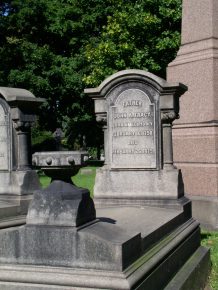
Born in New York, Tracy moved with his family to Erie County in 1799. Raised in Waterford, he came to Erie at age 18.
He entered into a partnership with P.S.V. Hamot for several years, and served as director of the U.S. Bank in Erie. He became a contractor on New York and Erie Railroad and Erie and North East Railroad, and served as director until 1853 when he became president. He then became Director of Railroads for Buffalo and Erie; Lake Shore and Michigan; and Erie and Pittsburgh.
He married Susan Jane Dobbins, daughter of Daniel Dobbins in 1826.
John F. Tracy
1827 - 1878

Born in Erie, the son of John A. Tracy, he is considered one of the fathers of the American railway system. He engaged in railroad construction carrying on in the tradition of his father, John A. Tracy, and became Superintendent of Railroads for Erie and North East railroad; a post he held during the Erie Railroad War. He served simultaneously as president of railroads for Chicago and Rock Island, and Chicago and Northwestern.
During the Erie Railroad War in 1853, Tracy held the position that railroad gauges be one size and did not yeild to the pressure of popular sentiment which sought to maintain a break in the continuous line in what was destined to become a great continental highway. He also built the first railroad bridge across the Mississippi River.
General Strong Vincent
1837 - 1863

Born in Waterford, PA in 1837, he was one of the Union's heroes in the Civil War. He was also in charge of the 83rd Pennsylvania volunteers at the Battle of Gettysburg in 1863. On the second day of the battle, the Confederacy had one great opportunity to outflank and destroy the Union Army by sweeping over Little Round Top, but Colonel Vincent's brigade never yielded. Vincent, who was mortally wounded in the action, was posthumously promoted to the rank of general by President Lincoln.
Prescott Metcalf
1813 - 1891

Born in Vermont, he came to Erie as a young man. He became associated with Rufus S. Reed, and eventually managed all his business affairs.
Metcalf was a prominent figure in the operation of stage coaches between Erie and Pittsburgh, construction of the Canada Southern Railway, the extension canal and the Erie and North East railroad.
He was incorporator of Erie Cemetery, Erie Gas Works and Dime Savings
Bank and founded the Burdett Organ Factory and Erie Malleable Iron
Works.
Honorable William A. Galbraith
1823 - 1898

Moving to Erie with his family in 1837, Galbraith attended Erie Academy and graduated from Allegheny College. In 1845 he graduated from the Dane Law School of Harvard University, and returned to Erie to practice law.
From 1846 to 1850 he was deputy attorney-general of Pennsylvania. He became the director of railroads for Sunbury and Erie and for Cleveland and Erie. He also served as president of the Erie Dime Saving and Loan Company.
He made large investments in real estate, particularly in Chicago where his "Galbraith Building" stood at the corner of Madison and Franklin streets. Galbraith, along with Herman Haupt, spent two years (1856-1858) supervising the building of the Hoosac tunnel through the Berkshire Hills in western Massachusetts.
Harry T. Burleigh
1866 - 1949
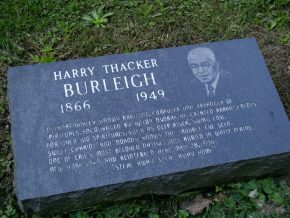
Born in Erie, Burleigh is regarded as the "savior of the spirituals," because he created arrangements for over 100 African-American folk songs, which developed under slavery and had been transmitted only in an oral tradition. A leading baritone of his time, he performed across the U.S. and before crowned heads of Europe. Buried in White Plains, N.Y. in 1949, he was reinterred in Erie Cemetery in May 1994.
Reid T. Stewart
1850 - 1872
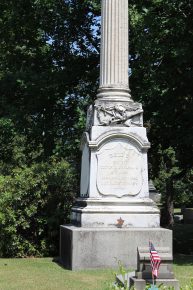
The only son of prominent Erie physician and surgeon, James L. Stewart, he graduated from West Point in 1871, and was commissioned second lieutenant to Company G, 5th U.S. Calvary. He was killed by Apache Indians near Tucson, Arizona Territory in 1872.
Colonel John W. McLane
1820 - 1862
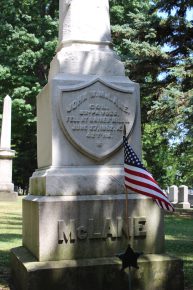
At the outbreak of the Civil War, McLane formed the 83rd regiment with men from Erie, Crawford, Warren, Venango, and Mercer Counties. In the Union invasion of Virginia in 1862, the 83rd distinguished itself at the Battle of Gaines Mill by preventing a Confederate breakthrough. McLane was mortally wounded in the battle.
Honorable Thomas Sill
1783 - 1856

Born in Connecticut, Sill opened law practice in Erie (1813) becoming Erie's first lawyer. He was a member of the militia as "Minute Man", who guarded the building of the ships in Erie during the War of 1812.
Sill was elected to the state legislature in 1823 and to Congress in 1826 and 1828. He became president of U.S. Bank at Erie in 1837.
Sill took a lively interest in public matters, especially projects of public improvement, and the cause of education serving as School Director, and as Trustee of Erie Academy for more than 30 years. Sill also served as Postmaster of Erie from 1849-1853, and as Burgess in 1816-17, 33-34, 43-44.

